Question Hi, I recently put my male beta in a new 5 gallon tank after keeping him in a bowl for about a week and a half. I just found this site and wish I had known about cycling a tank before putting him in. I did use the glass marbles from his bowl in the new tank and added some stress zyme. I am wondering how often I should do a water change while it is cycling.
Also, I am wondering how many and what kind of fish or maybe a frog I can add besides female betas' ( don't want babies) after the tank cycles. So glad I found this site before adding any more fish.
Also, I have a small 2 gallon hex tank with an air stone where I had been keeping a goldfish(gasp!). I was planning the 5 gallon tank for him before he died of ich. The pet store said he would be fine in that small tank and to change the water once a week. By day 5 he had a few white spots on his tail and as hard as I tried I couldn't save him. When I first got him he was constantly snapping at the top of the tank. I thought He was hungry and asked the pet store if I was underfeeding him. I understand now that that could have been a symptom of ich in his respiratory system before it manifested externally. So sad. I plan on getting a 30 gallon tank and doing it right as I am now a goldfish fan.
I however now have this tiny tank and my daughter wants to know if she can keep guppies or some small fish in it. Is it suitable for any fish. I actually only holds about a gallon and a half. If so do you still do only partial water changes as it had no filter and cannot cycle . Or does some beneficial bacteria build in those tanks also.
Sorry this is so long, I really don't want any more dead fish. Thanks so much, Diane
AnswerHey Diane,
Lets start with the living fish. Betta are pretty tough cookies, and will remain relatively inactive during the cycling period. Yes, it's plenty hard on them, and should be avoided, but they are capable of taking a bit of a bruisin'. It takes about a month to cycle, and the StressZyme will help speed that up. During the cycling process, change about 20% of the water a week, and do a weekly water test prior to the water change. Keep track of how fast the water becomes toxic, and change more frequently as needed. A simple dip-strip test will tell you really fast if you have ammonia build up (the most dangerous killer at this stage) and changing water out will help reduce it. AmQuel is a great product at controlling ammonia, and I use it on my tanks for fast ammonia reduction (usually around the time i work on filters, or move around substrate and stir up old waste, food, etc). The StressZyme wont cure the problem, nor will the AmQuel, but during the few weeks where ammonia is on the rise, these will help keep the toxins to a minimum. So, with use of product and testing, 20% a week, or more often depending on how fast the ammonia builds up. And keep that up for about a month while the bacteria in the tank builds up to a healthy level. Then 10% once a week should be enough.
As for what to add, In 5 gallons, with a betta, you could probably sneak in 5 neon tetra, 3-4 guppies (which would end up having babies), 2-3 zebra danios, or a small number of small fish of the like. The thing to keep in mind is keep the fish about the size of your thumb nail's width. Smaller fish will move faster, and be plenty colorful, but will typically have lower waste and feeding needs (thus less ammonia build up!). Also, to help reduce excess feeding, a generic tropical fish flake like Wardley's or TetraMin will feed your new aditions, as well as the betta.
Next for the 2 gallon tank. Basically any fish you like that you dont add to the 5 gallon with the betta will do well in that tank too. Endler's live bearers are amazing little guppies that stay tiny, and are bright orange and black. Typically, in a space that small you want 1 male and 2 females. Adding live plants (to either tank) will help keep the fish alive and healthy, by adding fresh O2, removing nitrates, and keeping a bit of control over other toxins too (that doesnt mean you can trust it to fix the problem completely, but it does help a little). The plants also offer hiding places for scared fish, which reduces stress and promotes good health. The only down side to keeping guppies is that guppies will breed monthly. The fry (baby fish) resulting of birthing once a month typically require to be separated from the parents, or else the parents will eat them! In a small tank, that can be a problem. However, dwarf frogs, tetra, and other small fish would survive better in that tank.
Personally, I dont like anything smaller then 10 gallons, and that's typically a temporary tank. The smallest tank i have running right now is 20 gallons, and it's home to guppies and small loaches. That being said, the 2 and 5 gallon tanks could house 3-4 different animals each, bu the work and risk involved are definately greater then that of a larger tank. If you're looking to keep animals in those tanks, small frogs, and small tetra are probably best. Keep in mind, tetra school and need groups accordingly. Betta are another option, keeping females in the 2 gallon, and a male with other fish in the larger tank would be a healthy option as well.
As for the goldfish, he could have been gasping for air from other causes as well. In 2 gallons, a single comet can use up the needed oxygen in a matter of hours. an aerator helps, but the high breathing rates of a hyper comet will suck up oxygen faster then most realize. Healthy, or not, a comet should never be kept in a tank smaller then 10 gallons. Especially due to the fact they can grow to be over a foot long! When picking new gold fish, be sure to avoid over stocking the tank. 2-3 gold fish is all that safely fit in a 30 gallon tank as adults, and it's ever so easy to drop 15 young goldfish in there, expecting to have them live. Within 3 years, those 15 fish will become 6 inches long each. At 35 years, the typical goldfish is about 12 inches, upto 14 inches in length. It's best to keep these mini monsters in fewer numbers from the start. And yes, under ideal conditions, these fish will live 35 years.
And as a footnote, all standing water begins to cycle. Any water with gravel, sand, a filter, or even sitting in a cup for a long time will begin to cycle. Cycling is simply the development of bacteria that converts toxins into less toxic chemicals. Ammonia becomes Nitrite, which in small amounts is not harmful. Over time, nitrite can become harmful in mild amounts, but it takes great lengths of time for that to happen. As nirtite breaks down from bacteria, it becomes a less toxic chemical called nitrate. Nitrate is pretty mild, and a moderate amount will take months to really poison a fish. Once noticed to be high, a water change and AmQuel should be used to tame the high levels immediately. Further investigation should be done to find the source of high levels of any chemical, and changes should be made to keep the water healthy.
Also, in emergancies, Boiling water for a few minutes and then cooling to back down to a safe range (70-80 for tropicals, 60-70 for goldfish) will remove chlorine, ammonia, dirt, metals, and other toxins. This is a good way to make emergancy water during a tank break, earthquake, or other emergancy (like conditioner shortage!).
Hope that this info will help you make an informed decisions with all your pets! Best wishes, and good luck!

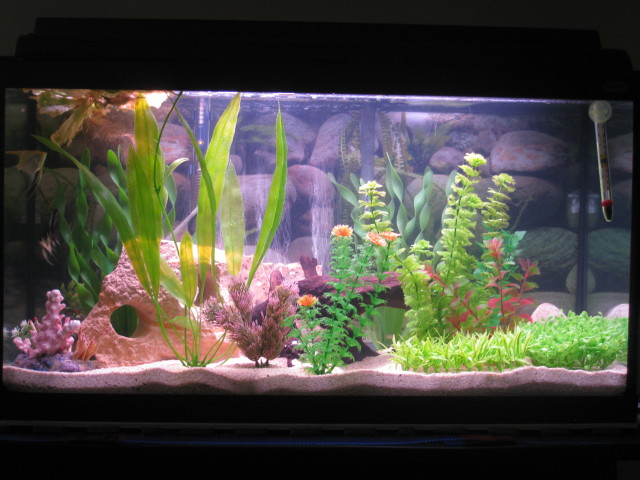 new aquarium
Question29 pic
QUESTION: does my aquarium look g
new aquarium
Question29 pic
QUESTION: does my aquarium look g
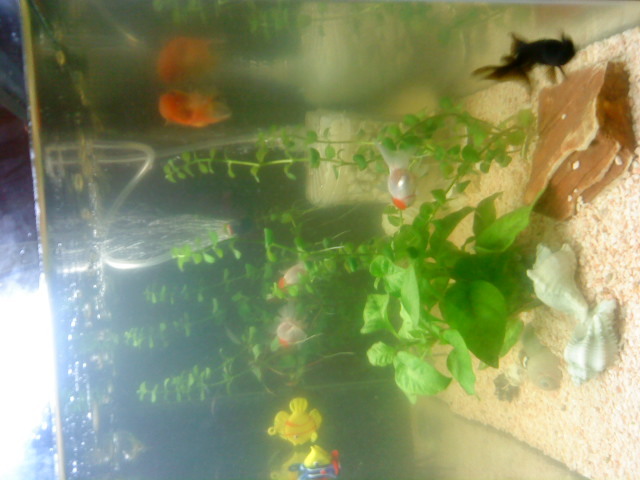 compatibility
Question
fish027
Hi Susan I have a 50litre tank
compatibility
Question
fish027
Hi Susan I have a 50litre tank
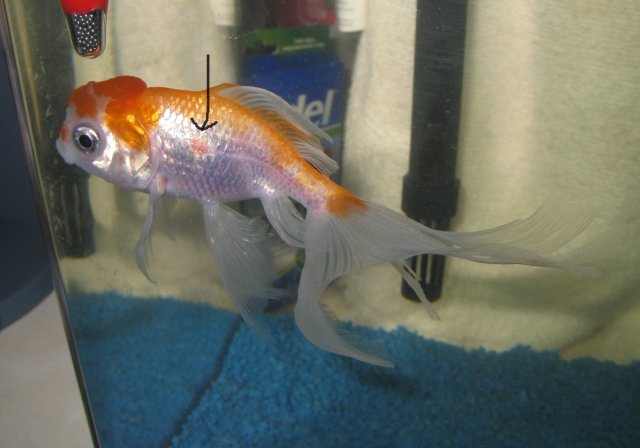 4 yr goldfish red spot
QuestionMy Goldfish
QUESTION: My goldfish sudden
4 yr goldfish red spot
QuestionMy Goldfish
QUESTION: My goldfish sudden
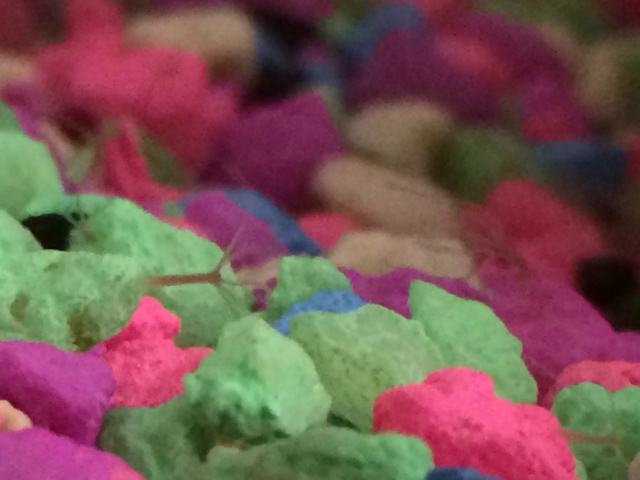 Whats in my tank?!?
Question
Squirming thing Squirming thing
T
Whats in my tank?!?
Question
Squirming thing Squirming thing
T
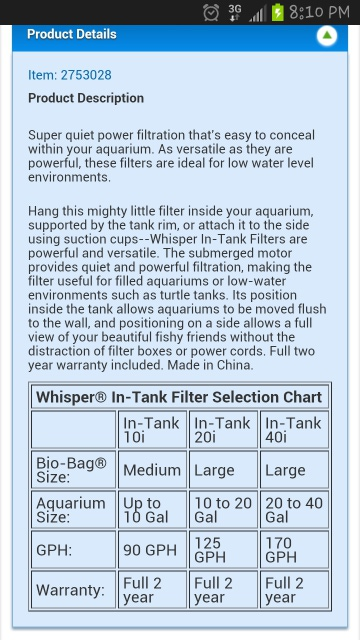 Filter
QuestionFilter
QUESTION: Hi Richard
I have a 10
Filter
QuestionFilter
QUESTION: Hi Richard
I have a 10